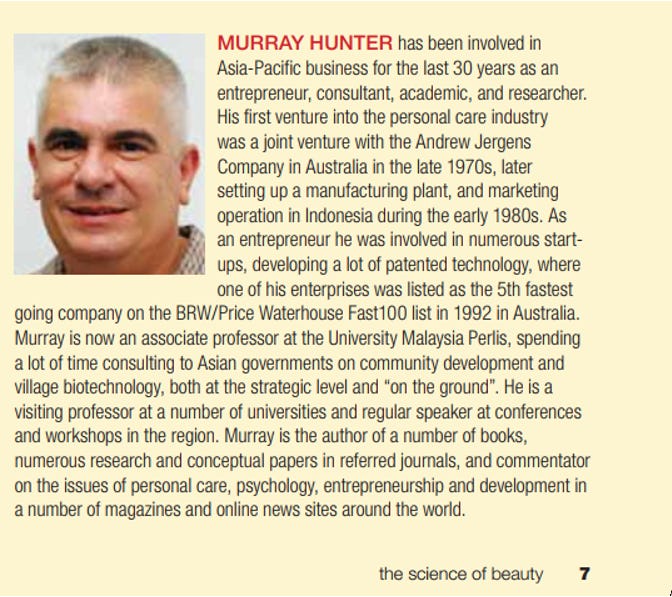Looking for New Breakthrough Products in Personal Care
Five simple things to do
Although the personal care industry could be considered dynamic, there are actually very few new products that actually change its nature. Most new products present only incremental changes to the nature of products, but confused as breakthroughs due to the marketing and media hype that accompanies their respective launches.
For a breakthrough to be a real breakthrough, the product, system incorporated within the product, materials used, or packaging must bring some form of 'beneficial novelty' to the user. Real breakthrough products must truly live up to the claims made by manufacturers and produce real benefits to consumers. This eliminates most products which claim to be novel.
We can only really see breakthroughs in hindsight and the passage of time, where we can see the impact of a product upon both market and consumer. One good example of this was P&G's Pert or Rejoice shampoo/conditioner which had a heavy influence upon consumers and manufacturers within the personal care industry for so many years.
A breakthrough can be considered a new idea which is transformed into a product at the most radical end, or a new innovative process, delivery system, or new ingredient at the more conservative end of the continuum of innovation. Any breakthrough requires someone to the technology and apply it to an opportunity. They must then be committed to go through all the processes, steps, and hurdles, to manifest the concept into a marketable product. Finally, the product must be seen as a breakthrough by the industry and consumers.
P&G Pert (Rejoice) a marketing breakthrough – using a simple formula change
So why are there so few breakthrough products emerging from the personal care industry?
This can be summarized as follows.
1. The industry although outwardly appearing glamorous, is deeply conservative in nature. Family owned entrepreneurial type medium sized companies that used to make a punt in the market are almost gone. The labs of the multinational companies are run by "MBA" types who lack the same visions that those "born into the industry" once had.
2. The chain store nature of the retail sector only wants "winners" and buyers don't want to take risks on new concepts unless supported with big dollars. The cost of failure is almost prohibitive, which also promotes conservativeness.
3. The personal care industry is incestuous in the way that it keeps to the same formulatory norms of the past. This is promoted by the strict regulatory mechanisms now in place across, Europe, the US, Japan, and Australia. The cost of incorporating anything really new into a product is almost prohibitive. Few new exciting companies with "new concept" raw materials are being created within the industry, just new companies offering the same.
Something new in the personal care industry is risky. Pioneering companies face the difficulties of untangling both the technical and market hurdles. Companies find it much easier to let other companies pioneer any new concept, and then jump on the bandwagon, should it find any success.
For those brave enough to launch any new innovation, potential failure can occur because of;
1. the product failing to constitute any real improvement over what is already available in the market,
2. very little real substance to the innovation (at least in the eyes of consumers),
3. not enough potential customers around who value the innovation or added benefits the new product provides, or
4. the innovating company didn't have the market and financial clout to get the product on supermarket or pharmacy shelves, or failed to promote it adequately.
That's why most potential innovations in the future are most likely to come from direct marketing companies based within the Asian region. This is a worry for Australian companies, as the locus of innovation is now geographically shifting.
Due to the nature of the personal care industry described above, most new innovations will be process and branding changes rather than technical.
It's going to be a long time before technical innovation can be afforded by companies within the industry due to the regulatory environment that now exists around most of the developed world today. Any technical innovation is really only possible from the labs of multinational corporations which spend a sizable proportion of revenue on R&D. So innovation from this quarter will come from some far off land to Australia, and most likely be incorporated into some global brand.
So for those brave enough to create and develop a breakthrough product, where can the inspiration come from?
1. Travel extensively. That is what Horst Rechelbacher, the late founder of Aveda did in conceptualizing his ideas and concepts behind the Aveda project. He also had a family involved in the salon industry which provided him with industry knowledge, so vital to specific industry innovation. Most often ideas will come from observing what you are not familiar with in far off lands.
2. Look for problems consumers have, that aren't solved satisfactorily at present.
3. Look for trends that are occurring from changes in demographics, and lifestyles of consumers. This is how the fragrances Charlie, Opium, and Poison came to being, all playing their themes upon the changing status of women in society during the 1970s and 80s.
4. Look at technology developments. These may not be restricted to just cosmetic materials, but also packaging, etc. Unilever has invested a lot of time and money into packaging developments with the recent application of a newly developed packaging technology that utilizes 15% less plastic on their Dove range.
5. Synthesize all you see above and come up with a hunch and run with it, no matter how silly it looks, until you see it for what it can potentially be in the marketplace. Think about it. Sticky notes and IPads sounded silly at the beginning, and video phones looked like something very sensible. Look how these concepts went in the market.
As you can see, future breakthroughs are more likely to be developed by companies which don't follow the standard profile. Innovative companies will more likely be those involved within the direct marketing sector in Asia, rather than the traditional markets of Europe, Japan, the US, and Australia.
The industry focus is rapidly shifting to Asia, and this is where the innovation will be. it's time to see whether your company is prepared for this new challenge.
Breakthroughs will come to those who successfully navigate this demographic shift, and apply technology to problems which affect consumers. These breakthroughs may no longer come from Europe, the US, and Japan, but from China, India, or Brazil. The technology behind the breakthrough may not necessarily be cosmetic technology, but could come from medicine or aerospace, or even IT. There is still so much we don't understand about the biomechanical behavior of skin, which leaves many avenues open for breakthroughs. Resource scarcity hints that leaps and bounds in biodegradable packaging will be made in the near future.
However, we may not really know what is a true breakthrough even when we see it. Too many products are managed with marketing and media hype such as anti-aging products today. We will only after some period of time know which products were true breakthroughs in personal care, sometime after they have been in the marketplace.
Originally published in The Science of Beauty, January 2015
One of the many articles I wrote as a resident columnist
You can subscribe for free emails of future articles here:






